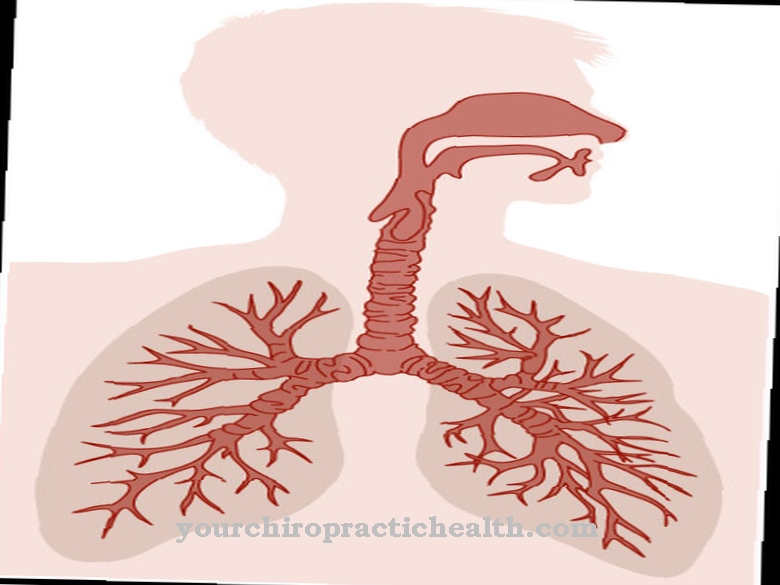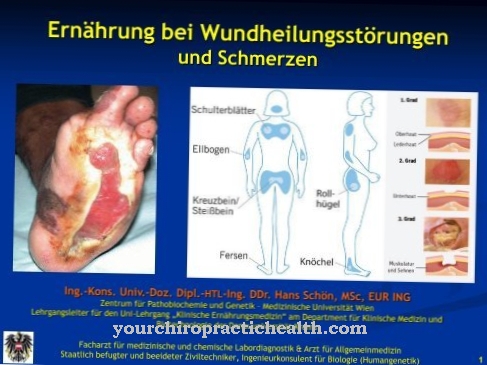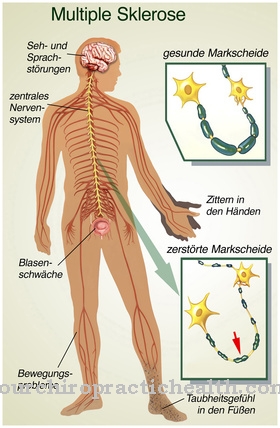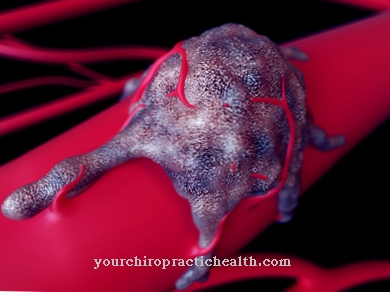The CHARGE syndrome is a genetic disease with a wide range of symptoms and clinical pictures. Particularly noteworthy here are a colomb of the eye, heart defects, atresia of the choans, reduced length growth and development delay, genital abnormality and an abnormality of the ear. Surgical corrections of the malformations are necessary. Many sick people can lead a relatively normal life within their means.
What is CHARGE Syndrome?

© joshya - stock.adobe.com
The CHARGE syndrome, too CHARGE association or Hall-Hittner Syndrome, is a rare genetic disease. Two thirds of those with CHARGE syndrome have one or more mutations in the CHD7 gene.
CHARGE is an acronym for the English names of the clinical pictures that typically occur in this syndrome: C.oloboma, Heart defect, A.tresia choanae, R.etarded growth and development, Genital abnormality, E.ar abnormality.
causes
The causes of CHARGE syndrome lie in genetics. About two thirds of the patients with CHARGE syndrome have one or more mutations in the CHD7 gene. This gene codes for a specific protein that is involved in chromatin remodeling.
It regulates gene expression by influencing the strength of the bond between DNA and histones (basic proteins in the cell nucleus). The organs of the eye, ear and nose are particularly affected in CHARGE syndrome, as the protein is especially formed in the cells of these organs. Autosomal dominant inheritance of the disease is possible. However, a spontaneous mutation without a family history is more common.
Symptoms, ailments & signs
The term CHARGE is an acronym for the English names of the diseases that frequently occur in this syndrome. These diseases are as follows:
Colomb: A congenital coloboma of the eye. The cleft of the eye cup does not close completely here. Due to this fact, a visual defect develops. A number of visual disturbances can occur. Among other things, visual field loss or light sensitivity should be mentioned. Other eye problems, such as detachment of the retina, are also possible.
Heart defect: Heart defects. With CHARGE syndrome, various heart defects can occur, some of which require surgical treatment.
Atresia choane: Atresia of the Choans. The nasal passages in CHARGE syndrome can be blocked or unusually narrowed. Surgical treatment is sometimes necessary several times in order to keep the corridors permanently open.
Retarded growth and development: Decreased growth in length and delay in development. This symptom is present in almost every patient in CHARGE syndrome. In any case, a doctor should rule out the possibility of delayed growth due to a lack of growth hormones. It is assumed that the developmental delays are due to various impairments of the sensory organs, chronic diseases and disorders of balance.
Genital abnormality: Genital abnormality. In people with CHARGE syndrome, the genital abnormality primarily affects the external genital organs, making this symptom easier to detect in male patients. These often have a reduced penis and non-palpable testicles. In female patients, smaller outer labia may be found.
Ear abnormality: Abnormality of the ear. In CHARGE syndrome, both the inner, middle and outer ear can be affected. Common problems are malformations of the bones in the middle ear, chronic accumulation of fluid in the middle ear, a narrow or missing ear canal, unusually shaped outer ears and hearing loss.
Not every person affected by the CHARGE syndrome has all the symptoms or clinical pictures and these do not always have to be very pronounced; the presence of some of these symptoms and only weak symptoms can represent a CHARGE syndrome.
Diagnosis & course
The diagnosis of CHARGE syndrome is divided into main features and secondary criteria. The diagnosis is made based on these features and criteria. The main criteria are coloboma of the eye, choanal atresia, a characteristic CHARGE ear, the deformity of the facial nerves (can lead to loss of sense of taste, facial paralysis, impaired sound and balance, problems with swallowing).
The secondary criteria are an underdevelopment of the genital organs, a development delay, heart defects, short stature, the formation of gaps in the facial area (can lead to further problems), tracheal fistulas, as well as the characteristic CHARGE face - there may be an asymmetry of the face, even if the face is not paralyzed is; An angular face shape with a broad, protruding forehead, sagging songs, a flat middle face and a small chin is also common.
Children born with CHARGE syndrome often require emergency surgery, long hospital stays, and constant medical monitoring. In the course of the life of those affected, the need for surgical interventions increases. However, the condition often improves beyond what is initially expected.
The number of adults with CHARGE syndrome is relatively low, which can be attributed to the fact that CHARGE syndrome has only existed as a disease in its own right since 1979. The number of adults living with the CHARGE syndrome will therefore increase within the next few years, so that statements can then be made about the conditions to be expected and the necessary surgical interventions in adulthood.
It can be said that a good development can be achieved very easily within the given possibilities. However, this requires support from medical and educational specialists. Parents in particular can have a positive influence on the development of their child with CHARGE syndrome by encouraging them as much as possible.
Parents should learn to understand their child's difficulties associated with CHARGE syndrome. In this way, you can offer him the support he needs so that he can fully exploit his possibilities.
Complications
CHARGE syndrome causes a number of different complaints and symptoms. In most cases, various malformations and delayed development occur. The person affected primarily suffers from a congenital heart defect. In the worst case, this can lead to the patient's death without treatment and must therefore be treated surgically.
Furthermore, there is a severe short stature and also a greatly delayed mental and psychological development. In many cases the patient is dependent on the help of other people in everyday life and cannot cope with it alone. Balance disorders and sensitivity disorders occur. These can extremely restrict the quality of life.
The malformations can also affect the genital organs and lead to abnormalities in them. It is not uncommon for those affected to be ashamed of these complaints and suffer from inferiority complexes as a result. CHARGE syndrome also leads to hearing loss.
A causal treatment of CHARGE syndrome is not possible. However, various surgical procedures can be used to relieve and limit the symptoms and symptoms of this disease.
When should you go to the doctor?
In most cases, CHARGE syndrome does not need to be re-diagnosed. The symptoms can be recognized before birth or immediately after birth, so that early treatment is also possible. A doctor should be consulted if the symptoms and malformations of this syndrome lead to restrictions and dangers in the child's everyday life. Above all, the child's heart and kidneys must be examined so that surgical interventions can be carried out in the event of illness.
The delayed development and mental retardation can be compensated with special support. A doctor should also be consulted if there is a genital abnormality. If the person concerned suffers from hearing problems or from malformations of the ears, these complaints must also be alleviated and treated. This can prevent complete deafness. In most cases, the symptoms will be diagnosed by a pediatrician. The treatment itself is then carried out by the respective specialist.
Doctors & therapists in your area
Treatment & Therapy
A causal treatment is not possible, the therapy consists mainly in the surgical removal of the symptoms, if this is possible. The corrections of the malformations are mostly necessary. Long hospital stays are common as part of these operations.
Outlook & forecast
As a rule, the CHARGE syndrome does not reduce the patient's life expectancy. The individual malformations and deformities on the body are corrected in various surgical interventions. While these are associated with side effects and risks, they are the only way to treat CHARGE syndrome.
If no treatment occurs, there will be no self-healing, but neither will the symptoms worsen. After the corrections, those affected can lead an ordinary life in most cases and are not restricted in their everyday life. A causal treatment of the disease is not possible because it is a hereditary disease. No further complaints or compilations occur after successful operations.
If the symptoms of CHARGE syndrome are not corrected, those affected often suffer from psychological complaints or from depression. Since in some cases the nasal passages can also be blocked, an immediate operation is necessary, as the child would otherwise die immediately after birth. The mental retardation and slowed development can only be treated to a limited extent in the case of CHARGE syndrome. As a rule, the patients suffer from mental retardation their entire life and are therefore dependent on outside help in their everyday life.
prevention
Since it is a genetic and also very rare disease, prevention is not possible.
Aftercare
As a rule, direct follow-up care cannot be carried out in the case of CHARGE syndrome. The individual symptoms must be treated depending on their severity, whereby the affected person can usually lead an ordinary life without restrictions.
Early diagnosis and treatment of the CHARGE syndrome have a very positive effect on the further course and can prevent complications. Since the treatment of the syndrome mainly takes place with the help of surgical interventions, the person affected has to recover after these interventions and generally be prepared for longer stays in a hospital.
Contact with family and friends can also be very positive and have a positive effect on the course of the disease. However, symptoms cannot always be completely eliminated, so complete cure cannot always be achieved. As CHARGE syndrome is often associated with psychological complaints, psychological treatment should always be carried out.
Parents or relatives can also take part in this psychological treatment, as they are also affected by the disease. Due to the slowed development of the children, they are dependent on permanent support to compensate for this.
You can do that yourself
CHARGE syndrome is a genetic disease that cannot be treated causally. Serious malformations, especially of the heart, can, however, already be identified during the prenatal diagnosis. Since the syndrome can be inherited, pregnant women whose families or families-in-law have already been diagnosed with the disorder should undergo all preventive medical check-ups and speak to their doctor about the CHARGE syndrome.
If severe malformations or developmental disorders are to be expected, a medically indicated termination of pregnancy is possible. Parents who decide to carry the pregnancy to term should be aware in good time of the special burdens they will face.
Children who suffer from CHARGE syndrome usually need one or more emergency operations right after birth. The treatment of the disease is very intensive, especially during the first few years, and is associated with regular hospital stays, visits to the doctor and permanent home nursing. This not only stresses the parents concerned, but also any existing siblings. The families must therefore take organizational measures in good time to integrate the sick child and their special needs into everyday family life and work.
In order to guarantee the best possible support for the child according to his or her possibilities, not only competent doctors, but also other specialists, for example special educators, speech therapists and physiotherapists, should be called in early on.



.jpg)























